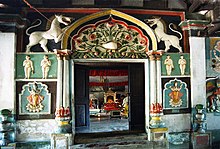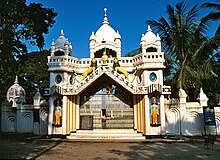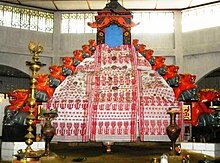
Srimanta Sankardev was a 15th–16th century Assamese polymath; a saint-scholar, poet, playwright, dancer, actor, musician, artist social-religious reformer and a figure of importance in the cultural and religious history of the Bhakti movement in Assam. He is credited with building on past cultural relics and devising new forms of music (Borgeet), theatrical performance, dance (Sattriya), literary language (Brajavali). Besides, he has left a literary oeuvre of trans-created scriptures, poetry and theological works written in Sanskrit, Assamese and Brajavali. The Bhagavatic religious movement he started, Ekasarana Dharma and also called Neo-Vaishnavite movement, influenced two medieval kingdoms – Koch and the Ahom kingdom – and the assembly of devotees he initiated evolved over time into monastic centers called Sattras, which continue to be important socio-religious institutions in Assam and to a lesser extent in North Bengal.

The Moamoria rebellion (1769–1805) was an 18th-century uprising in Ahom kingdom of present-day Assam that began as power struggle between the Moamorias (Mataks), the adherents of the Mayamara Sattra, and the Ahom kings. This uprising spread widely to other sections of Ahom kingdom including disgruntled elements of the Ahom aristocracy leading to two periods in which the Ahom king lost control of the capital. Retaking the capital was accompanied by a massacre of subjects, leading to a steep depopulation of large tracts. The Ahom king failed to retake the entire kingdom; a portion in the north-east, Bengmara, became known as Matak Rajya ruled by a newly created office called Borsenapati, became a tribute-paying but virtually independent territory.

Ekasarana Dharma is a neo-Vaishnavite Hindu monolithic Hindu vaishnav sect propagated by Srimanta Sankardeva in the 15th-16th century in the Indian state of Assam. It reduced focus on Vedic ritualism and focuses on devotion (bhakti) to Krishna in the form of congregational listening (shravan) and singing his name and deeds (kirtan).
Madhavdev (1489–1596) is an important preceptor of the Ekasarana Dharma known for his loyalty to his guru, Srimanta Sankardev as well as his artistic brilliance. Initially a sakta worshipper, he was converted to Ekasarana Dharma by Sankardev and became his most prominent disciple. He became the religious as well as artistic successor of Sankardeva after the latter's death in 1568. He is known particularly for his book of hymns, the Naam Ghosa, as well as a large selection of songs called Borgeets.
Narayanpur is a developmental block (place) located in the Lakhimpur district of the northeastern Indian state of Assam, within the North Lakhimpur subdivision. It falls under the Bihpuria constituency of the Assam Legislative Assembly and is served by the Narayanpur Police Station. The town of Narayanpur, situated at the center of the block, serves as the headquarters of the Deori Autonomous Council, the governing body of the Deori ethnic group. Narayanpur is also notable as the birthplace of several famous Vaishnavite saints, including Mahapurush Madhavdev.

Dakhinpat Satra, situated in the south-east corner of Majuli. It is one of Assam's most well-renowned and principle monastic Satra, established by Banamali Dev Goswami in 1654 under the patronization of Ahom King Jayadhwaj Singha. This Satra particularly belongs to Brahmasamhati sect, founded by Damodardev.

Damodardev (1488–1598) was sixteenth century Ekasarana preceptor from Nalaca, Nagaon. Damodardev was a follower of Sankardeva's Ekasarana dharma order. He started his own order after the death of Sankardeva that came to be called the Brahmasamhati, which admitted Brahmanical rituals and greater adherence to the caste system alongside the namadharma of Sankardev. He was succeeded by Bhattadeva.
Gopaldev (1540–1611) was an Indian poet, dramatist and chief preacher of the Vaishnava sect in eastern Assam. He was belonged from Bhabanipur, Assam so people called him as Bhabanipuria Gopal Ata. He is also a disciple of Mahapurush Shrimanta Sankardev.

Barpeta Satra is a well-known sattra situated at Barpeta in the Indian state of Assam. It was established by vaishnavite saint Madhabdev in 1505 shakabda. The earlier name of the satra was Barpeta Than.

Basudev Than or Narua Satra is a satra located in Dhakuakhana, Lakhimpur, Assam. It was first established in the 14th century by the Chutia king Satyanarayan. Originally known as Laumura Satra, this satra is well known in Assam and other parts of India.

Madhupur Satra is a religious institutional center associated with the Ekasarana tradition of Vaishnavism, situated in Cooch Behar, the Indian state of West Bengal. It was established by Assamese Vaishnavite monasteries for religious practices in the mid 16th-century during Koch kingdom (1515–1949). The great Bhakti Saint Mahapurusha Srimanta Sankardeva (1449–1568) and his disciple Mahapurusha Madhavadeva died here. Madhupur satra is also called as Dahmukutor than; 'dahmukut' means 'bhiti' or living houses of ten disciples (bhaktas) of Srimanta Sankardeva. The name satra originates in the Bhagavata Purana in Sanskrit (sattra), and is used in the sense of an assembly of devotees.
Moinbari Satra is one of the major Sankardeva's religious establishment at Moinbari in border area Barpeta, Goalpara and Bongaigaon Districts in Assam and previously it was border of Ahom and Koch Kingdom. It was founded by Narayan Das Thakur Ata and it is a center of art, culture, literature, and classical studies of minority Muslim dominated Moinbari area.

The Moamoria were the adherents of the egalitarian, proselytizing Mayamara Satra of 18th-century Assam, who initiated the Moamoria rebellion against the Ahom kingdom in the 18th century. The rebellion weakened the Ahom kingdom to such an extent that the kingdom became vulnerable to repeated Burmese invasions of Assam and the subsequent colonization by the British. The Moamorias were also called Mataks. Over time, the main groups that had supported the Ahom kingdom came to owe allegiance to the Moamara sattra: Morans, the Sonowal Kacharis (gold-washers), Chutias, professional castes such as Hiras (potters), Tantis (weavers), Kaibartas, and Ahom nobles and officers. The largest group among the Mataks were the Morans, followed by the Chutias.
The Brittial Bania/Bania is an ethnic community in Assam, India. The group traces its roots to a merchant community who reached Assam (Kamarupa) in ancient times. Some historians claim that after the Austric group migrated to ancient Assam, the next group of people who arrived was the Dravidian group, who are represented by the Bania and Kaibbartas today. Unlike the mainland Baniya community, this community of Assam is recognized as a Scheduled Caste by the government of India.
Aniruddhadev (1553–1626) was a 16th-century Ekasarana preceptor from Assam. Born to a Bhuyan named Gondagiri, Aniruddhadev was a disciple of Gopal Ata and the founder of the Mayamara satra of the Kalasamhati, the followers of which revolted against Ahom kingdom. who priotized the Brahmasamhati.

Bordowa 'Batadrava' Than is a holy pilgrimage site in Nagaon, Assam. It is located in the birthplace of the great Assamese saint and social reformer Srimanta Sankardev. Sankardev at the age of 19, established the Bordowa Than in 1468, it is also the first Namghar or Than constructed. The rituals of this Than is conducted according to the norms of Purush sanghati. The pilgrimage site is located at Batadrava, about 16 km from Nagaon city and it covers an area of 16 bigha.

Painting of Assam, the art of manuscript painting in the Assam region developed through the movement of Vaishnavism. Vaishnava saints were primarily responsible for the establishment of manuscript painting tradition in Assam. A large number of manuscript paintings were done and copied during the 16th to 19th centuries. Assam has a very long history of visual art from the pre-historic age up to the end of Ahom rule in 1826 A.D. Among the earliest reference of Assam painting, the account of Chinese traveller Xuanzang records that King Bhaskaravarman of Kamarupa who was a friend of King Harsa of Kanauj presented the king “Carved boxes of panels for painting with brushes and gourds."

Badala Padma Ata (1546-1678) was a Vaisnavite Preacher and a saint who propagated his teaching during 16th and 17th centuries. He was one of the principle founder of Nika Samathi along with Mathuradasa Ata and Keshav Ata, and established 24 Satras in Upper Assam including the famous Kamalabari Satra. He first met Madhavdev at Bhela Satra and became a very devout disciple of him.

Sri Sri Auniati Satra is a satra or monastery located in the Majuli river island in Assam, India, that adheres to the Brahma Sanghati of the Ekasarana Dharma, a socio-religious and cultural movement initiated by Srimanta Sankaradeva, who was born in 1449 CE. It is one of the four "raj satras" or royal satras associated with the Ahom dynasty. It is the first satra patronised by the kingdom. It is usually believed that this satra was established in the year 1653 CE, with the initiative of Ahom king Jayadhwaj Singha, the first head monk or satradhikar being Sri Sri Niranjana Deva Goswami, even though different opinions exist.
















